Nicholas Hawksmoor was an English architect. He was a leading figure of the English Baroque style of architecture in the late-seventeenth and early-eighteenth centuries. Hawksmoor worked alongside the principal architects of the time, Christopher Wren and John Vanbrugh, and contributed to the design of some of the most notable buildings of the period, including St Paul's Cathedral, Wren's City of London churches, Greenwich Hospital, Blenheim Palace and Castle Howard. Part of his work has been correctly attributed to him only relatively recently, and his influence has reached several poets and authors of the twentieth century.
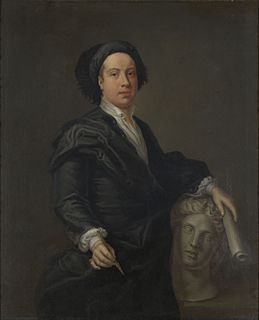
William Kent was an eminent English architect, landscape architect, painter and furniture designer of the early 18th century. He began his career as a painter, and became Principal Painter in Ordinary or court painter, but his real talent was for design in various media.
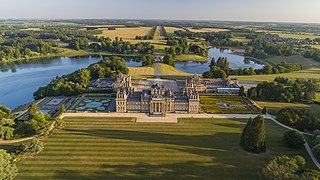
Blenheim Palace is a country house in Woodstock, Oxfordshire, England. It is the seat of the Dukes of Marlborough and the only non-royal, non-episcopal country house in England to hold the title of palace. The palace, one of England's largest houses, was built between 1705 and 1722, and designated a UNESCO World Heritage Site in 1987.
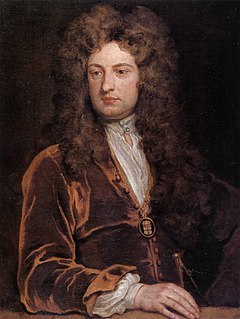
Sir John Vanbrugh was an English architect, dramatist and herald, perhaps best known as the designer of Blenheim Palace and Castle Howard. He wrote two argumentative and outspoken Restoration comedies, The Relapse (1696) and The Provoked Wife (1697), which have become enduring stage favourites but originally occasioned much controversy. He was knighted in 1714.
John James was a British architect particularly associated with Twickenham in west London, where he rebuilt St Mary's Church and also built a house for James Johnson, Secretary of State for Scotland, later Orleans House and since demolished. Howard Colvin's assessment of him was that of "a competent architect, but he lacked inventive fancy, and his buildings are for the most part plain and unadventurous in design".

Palladian architecture is a European architectural style derived from the designs of the Venetian architect Andrea Palladio (1508–1580). What is today recognised as Palladian architecture evolved from his concepts of symmetry, perspective and the principals of formal classical temple architecture from the Ancient Greeks and Romans traditions. From the 17th century Palladio's interpretation of this classical architecture was adapted as the style known as "Palladianism". It continued to develop until the end of the 18th century.

Seaton Delaval Hall is a Grade I listed country house in Northumberland, England, near the coast just north of Newcastle upon Tyne. Located between Seaton Sluice and Seaton Delaval, it was designed by Sir John Vanbrugh in 1718 for Admiral George Delaval; it is now owned by the National Trust.
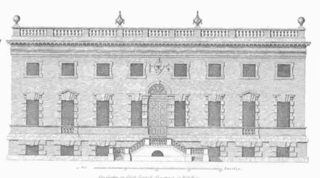
Colen Campbell was a pioneering Scottish architect and architectural writer, credited as a founder of the Georgian style. For most of his career, he resided in Italy and England. As well as his architectural designs he is known for Vitruvius Britannicus, three volumes of high-quality engravings showing the great houses of the time.

Easton Neston is a large grade I listed country house in the parish of Easton Neston near Towcester in Northamptonshire, England. It was built by William Fermor, 1st Baron Leominster (1648–1711), in the Baroque style to the design of the architect Nicholas Hawksmoor. Easton Neston is thought to be the only mansion which was solely the work of Hawksmoor. From about 1700, after the completion of Easton Neston, Hawksmoor worked with Sir John Vanbrugh on many buildings, including Castle Howard and Blenheim Palace, and often provided technical knowledge to the less qualified Vanbrugh. Hawksmoor's work was always more classically severe than Vanbrugh's. However, Easton Neston predates this partnership by some six years.

The architecture of England is the architecture of modern England and in the historic Kingdom of England. It often includes buildings created under English influence or by English architects in other parts of the world, particularly in the English and later British colonies and Empire, which developed into the Commonwealth of Nations.
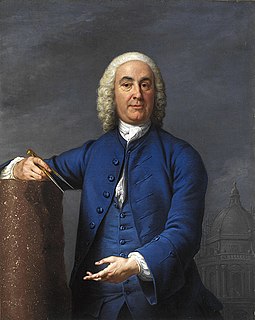
James Gibbs was one of Britain's most influential architects. Born in Scotland, he trained as an architect in Rome, and practised mainly in England. He is an important figure whose work spanned the transition between English Baroque architecture and Georgian architecture heavily influenced by Andrea Palladio. Among his most important works are St Martin-in-the-Fields, the cylindrical, domed Radcliffe Camera at Oxford University, and the Senate House at Cambridge University.
The year 1722 in architecture involved some significant events.

Hugh May was an English architect in the period after the Restoration of King Charles II. He worked in the era which fell between the first introduction of Palladianism into England by Inigo Jones, and the full flowering of English Baroque under John Vanbrugh and Nicholas Hawksmoor. His own work was influenced by both Jones' work, and by Dutch architecture. Although May's only surviving works are Eltham Lodge, and the east front, stables and chapel at Cornbury House, his designs were influential. Together with his contemporary, Sir Roger Pratt, May was responsible for introducing and popularising an Anglo-Dutch type of house, which was widely imitated.

Dilkusha Kothi is the remains of an eighteenth-century house built in the English baroque style in the quiet Dilkusha area of Lucknow in India. Today there are only a few towers and external walls as a monument, though the extensive gardens remain. The house was shelled during its involvement in the Lucknow siege in 1857 together with the Residency and the nearby school of La Martiniere.

Roger Morris was an English architect whose connection with Colen Campbell brought him to the attention of Henry Herbert, 9th Earl of Pembroke, with whom Morris collaborated on a long series of projects.
Baroque! From St Peter's to St Paul's is a three-part BBC Four documentary series on the painting, sculpture and architecture of the Baroque period. It was written and presented by Waldemar Januszczak and first broadcast in March 2009. It is named after its start in the square of Saint Peter's Basilica and its end at St Paul's Cathedral.
William Etty was an English architect and craftsman, best known for designing Holy Trinity Church, Leeds and (probably) Holy Trinity Church, Sunderland.

Burford Methodist Church is a baroque building in the High Street of Burford, Oxfordshire. It was built between about 1715 and 1730 as a private house and converted in 1849 to a Wesleyan Chapel. It is a Grade II* Listed Building.

Goose-Pie House was a small English Baroque house built by John Vanbrugh in Whitehall, London, in 1701. The house was demolished in 1898. The site now lies under the southeast corner of the Old War Office Building on Whitehall, near the Gurkha Memorial statue on Horse Guards Avenue.

















